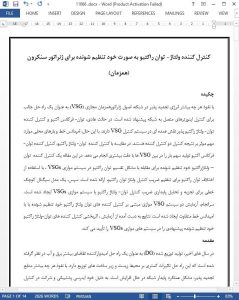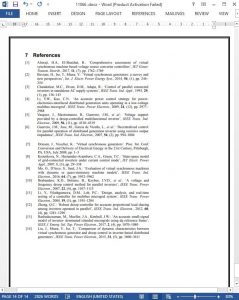Abstract
With a higher and higher penetration of renewable energy in the grid, the principle of the virtual synchronous generator (VSG) is proposed as an attractive solution to controlling the grid-connected inverters. In common, active power-frequency and reactive power-voltage controllers play major roles in VSG control system. However, the line impedance and local loads are the critical case effecting on the control result of the two controllers. Compared with reactive power-voltage controller, active power-frequency controller is more easier to product the load sharing among the VSGs accurately. This paper presents a self-adaptable reactive power-voltage controller to deal with the sharing problem of reactive power in the parallel VSGs system, using the reactive power difference to adjust reactive power-voltage control coefficient. Then, a linearised small-signal model is established for stability analysis of the reactive power-voltage control coefficient to the parallel VSGs system. Finally, an experiment of two parallel VSGs system based on the self-adaptable reactive power-voltage controllers is performed, with different line impedance. Results obtained from the experiment verify the effectiveness of the proposed self-adaptable reactive power-voltage controllers in the parallel VSGs system.
1 Introduction
In the recent years, distributed generation (DG) has recently been considered as a promising solution to meet the increased demand for utility with smaller effects on the environment and distribution infrastructures. With the higher and higher penetration of renewable energy sources, the problem of grid steady operation is increasingly severe. With lacking inertia needed to support and participating in the frequency and voltage control of an AC system, the renewable energy sources (RESs) inverters are hence unable to contribute to the improvement of system stability [1]. This issue can be addressed through the application of the concept of virtual synchronous generator (VSG), which combine VSC and synchronous generator (SG) characteristics. The VSG control algorithm of a power electronics inverter is a control feature that can be added to a converter controller to enable it to behave as an SG [2].
5 Conclusion
Active power-frequency and reactive power-voltage controllers play a major role in VSG control system. However, the line impedance and local loads are the critical case impacting on the control performance of the two controllers. Here, a self-adaptable reactive power-voltage controller is proposed to deal with the sharing problem of reactive power in the parallel VSGs system, which uses the reactive power difference to adjust reactive powervoltage control coefficient. For the stability analysis of the parallel VSGs system with the proposed self-adaptable reactive powervoltage controller, a linearised small-signal model is established, and the parametric sweep results of line impedance are analysed. Finally, the experimental results obtained in the laboratory are presented before drawing the final conclusions.











